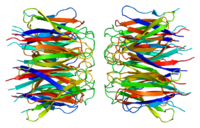
Photo from wikipedia
Abstract Purpose: BRD9 is a defining component of the noncanonical SWI/SNF complex, which regulates gene expression by controlling chromatin dynamics. Although recent studies have found an oncogenic role for BRD9… Click to show full abstract
Abstract Purpose: BRD9 is a defining component of the noncanonical SWI/SNF complex, which regulates gene expression by controlling chromatin dynamics. Although recent studies have found an oncogenic role for BRD9 in multiple cancer types including multiple myeloma, its clinical significance and oncogenic mechanism have not yet been elucidated. Here, we sought to identify the clinical and biological impact of BRD9 in multiple myeloma, which may contribute to the development of novel therapeutic strategies. Experimental Design: We performed integrated analyses of BRD9 in vitro and in vivo using multiple myeloma cell lines and primary multiple myeloma cells in established preclinical models, which identified the molecular functions of BRD9 contributing to multiple myeloma cell survival. Results: We found that high BRD9 expression was a poor prognostic factor in multiple myeloma. Depleting BRD9 by genetic (shRNA) and pharmacologic (dBRD9-A; proteolysis-targeting chimera; BRD9 degrader) approaches downregulated ribosome biogenesis genes, decreased the expression of the master regulator MYC, and disrupted the protein-synthesis maintenance machinery, thereby inhibiting multiple myeloma cell growth in vitro and in vivo in preclinical models. Importantly, we identified that the expression of ribosome biogenesis genes was associated with the disease progression and prognosis of patients with multiple myeloma. Our results suggest that BRD9 promotes gene expression by predominantly occupying the promoter regions of ribosome biogenesis genes and cooperating with BRD4 to enhance the transcriptional function of MYC. Conclusions: Our study identifies and validates BRD9 as a novel therapeutic target in preclinical models of multiple myeloma, which provides the framework for the clinical evaluation of BRD9 degraders to improve patient outcome.
Journal Title: Clinical Cancer Research
Year Published: 2023
Link to full text (if available)
Share on Social Media: Sign Up to like & get
recommendations!